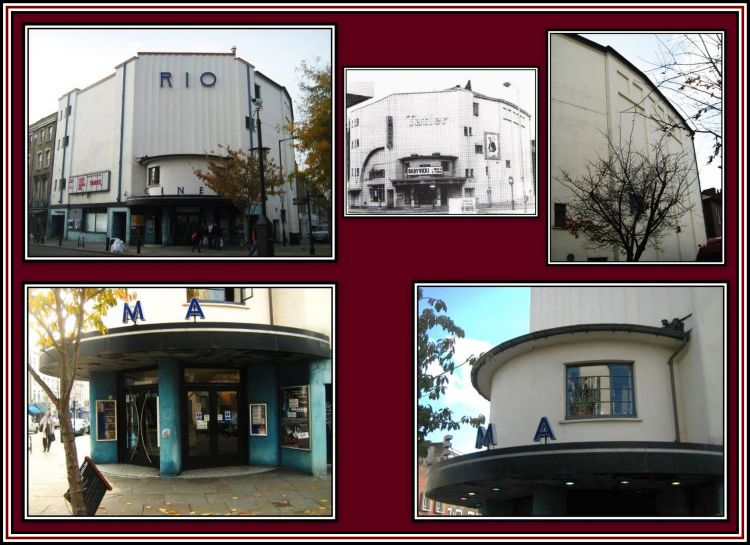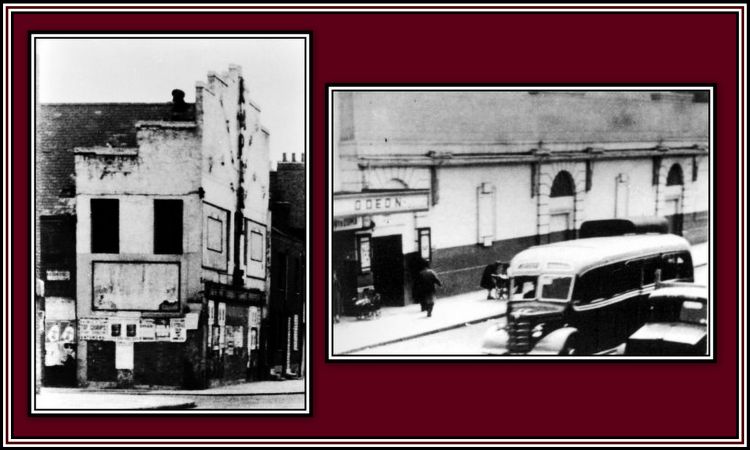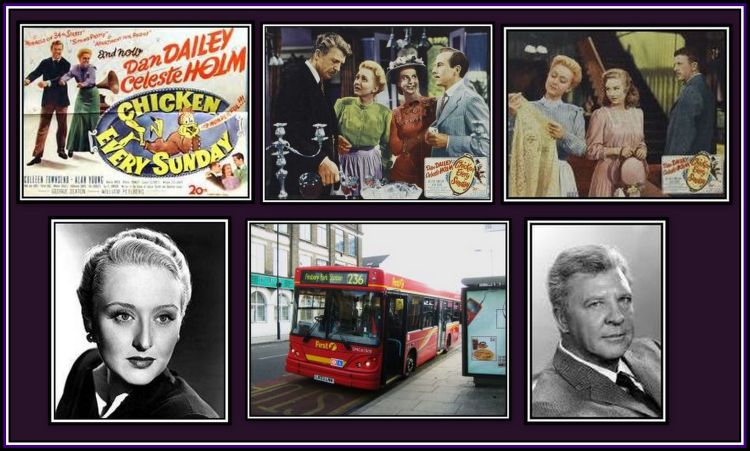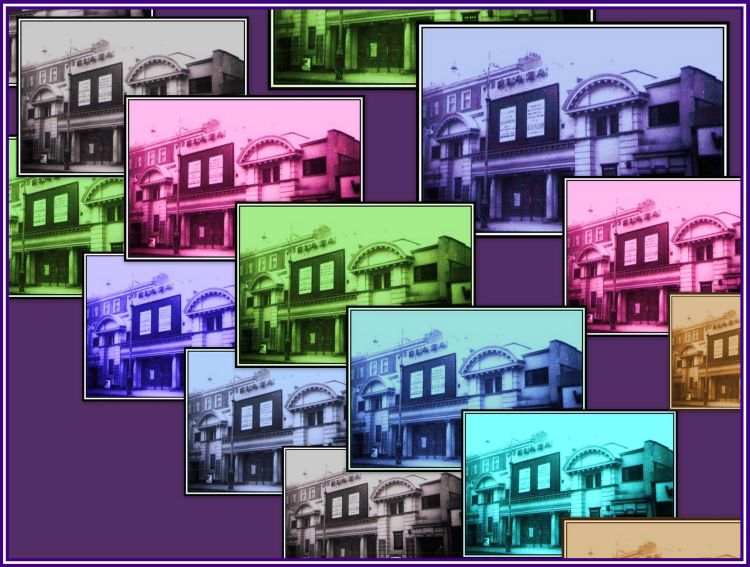
A PERFECT DAY
| |
 |
| Click on the collage to hear another version of A Perfect Day |
| When we used to visit the Ridley Road Market, Kingsland Road had three cinemas, each within close proximity: the Rio, the Odeon and the Plaza, which was to become one of my favourite cinemas. |
| |
 |
| |
| By the time my mother had had enough of shopping, I was ready to either go home or go to the pictures. There was never any doubt as to which cinema we would go, as it was always the Plaza. To be honest, at this time I had no knowledge of the Rio or as it must have been known as at that time, the Classic. I do not recall ever having seen the cinema until recently, as it sits on the corner of Kingsland Road and John Campbell Road further along the road from the market. This I regret since the Rio is obviously an interesting and a fine cinema. We never went to the Odeon either, as there were closer Odeons to where we lived and which were showing the same programme. |
| |
 |
The Odeon Dalston
Left: exterior & auditorium; Right: middle & bottom, the site today |
| |
The Plaza Dalston was an independent cinema and not associated with any of the major circuits. What I liked about the cinema was that its policy was to screen double features of previously screened films and did not specialize in any particular genre. Although we did not visit this cinema with any regularity, the films that we saw there are still vivid in my memory since they were immensely enjoyable and, over time, several have been acclaimed as classics and are often shown on the more discerning television channels.
The Plaza was operated by Kingsland Pictures Ltd and opened in December 1911. The building began in a shop and was converted into a cinema by the architect, William Watson. It was originally known as the Kingsland Imperial Picture and seated 500. In 1930, sound equipment was installed and in 1933, it was enlarged and refurbished and reopened as the Plaza. The cinema continued as an independent until December 1959 when it was closed. The final screenings at the Plaza were Curse of the Undead and Terror in the Midnight Sun. The building underwent conversion back into a shop on the lower floor and a snooker hall above. In the spring of 2009, the building was demolished and the site is now part of the Dalston Junction Station.
My affection for the Plaza Dalston was unlike that which I felt for the Excelsior and the Essoldo in Bethnal Green. The Excelsior was special to my mother and so became special to me while the Essoldo was held in high esteem thanks to the films that it screened. Although my mother liked the Plaza, it was not special to her. It was neither grand nor glorious and the films shown there were not as grandiose as those of the Essoldo. However, and to be fair,several of the films seen there have had a more lasting impression on me than many that once impressed me with their flashiness. No, the Plaza was, and is, special to me as a visit there formed part of what I would consider to be a perfect day.
I cannot remember much about the cinema despite my affection for it. I suspect that this is due in part to my age. At that time, I was far more interested in what films were being shown rather than the architecture and the décor of the building. I do remember that the building was in need of some refurbishment. It was somewhat drab in appearance and in dire need of some paint. I believe that there were no glass cases outside the cinema to display film stills, but I believe there were once were several on each side of the entrance doors. On one occasion I recall that the foyer, which was remarkable for its lack of decoration, had a board and easel set up to the left of the box office, which was on the right wall. The board displayed a homemade advertisement naming the films being screened.
Patrons entered the cinema at the back of the auditorium by passing through a series of doors in the foyer. I do not believe that there was a circle. If there was, we never sat in it. I remember that the auditorium décor was also drab and in need of revamping. I recall that the seats were comfortable and not broken or in a poor state. Had they been, my mother would never have returned to the cinema. She had strict views on how a cinema should be and refused to enter either the Museum on the Cambridge Heath Road or the Empire on Roman Road since she felt that they were dirty and in a terrible condition. Although drab and in need of some paint, the Plaza was obviously acceptable to my mother and offered a certain coziness that was conducive to settling back and enjoying the programme. |
| |
 |
The Empire Roman Road & the Museum (Odeon) Cambridge Heath Road - both demolished |
| |
Whenever we went to the Plaza, it was never crowded. In fact, there were few other patrons present. This suited me fine. I prefer to have no one about me when I watch a film, as I do not wish to hear their comments. My mother would always sit on the end of a row, on the aisle, and once we found suitable seats, we settled back for an enjoyable late afternoon.
In those days, two films were shown together with trailers and advertisements. I don’t believe that the Plaza screened a newsreel since it was not associated with a major chain. Like most of the cinema-going public of that era, we went into the cinema at a time that was convenient to us and rarely, if ever, at the start of a film. For some reason, this never seemed to bother patrons and certainly did not spoil their pleasure.
I don’t recall there being an interval in the programme. There was no musical interlude, as far as I can remember. There most certainly was not an organ. I also do not remember any ice cream lady, not that my mother would have allowed me to have one, since she felt that I had eaten enough during our stroll through the market. I was able to live with this as I knew that at some time during the screening, my mother would remember those extra bagels that she had bought and I would be slipped one to eat. My mother also had strict views regarding the eating in public. Firstly, she did not agree with it, but if one did eat in public then it had to be done without noise and without making crumbs. When seated comfortably in such a cinema where there were few patrons in the vicinity, she was not adverse to the occasional nosh as long as the rules were kept. I remember that I would be given a bag to hold my bagel, which also served to catch my crumbs. People that know me often comment that when I eat, I do not seem to make crumbs. This ability was perfected from quietly eating in the cinema without others noticing.
The very first film that I saw at the Plaza was Kings Row and I remember that it left me with a number of unanswered questions. The film was based on a controversial book and told the story of growing up in a small American town at the turn of the century. The book dealt with a number of subjects that were considered taboo at the time of shooting and were not allowed to be explored fully in the screenplay. As a result, the storyline implied much, explained little and left a young viewer with many unanswered questions, which his mother did not answer. The book was once very popular and is considered to be a forerunner of Peyton Place.
|
| |
 |
| Click on the pictures to see clips from the film |
| |
| Kings Row stars Robert Cummings, Anne Sheridan, Ronald Reagan and Betty Field, as well a large number of brilliant supporting actors and actresses. Although not well received by the critics, Ronald Reagan was singled out for his acting. However, he was unable to capitalize on his success, as he was called-up soon after its release for service in the military during the Second World War. Other noteworthy features of this film were the music and the photography. The film is shown on television at times and I have to admit that I still enjoy watching it, although I do find Robert Cummings’ acting to be stilted. Whenever I settle down to watch it once more, I like to surround myself with suitable foods, which I eat silently and without making any crumbs. |
| |
 |
| |
A second film that I remember seeing at the Plaza and which I also enjoyed very much was Chicken every Sunday. This filmstars Dan Dailey, Celeste Holm and a young Natalie Wood. My mother always enjoyed the films of Dan Dailey and especially liked his musicals. Although this was not a musical, she still enjoyed watching him, as he had a happy-go-lucky style, which was on full-display in this film. The film told the story of a married couple and the trials and tribulations of their life together at the turn of the century. The film began with the wife seeking out a lawyer since she wanted a divorce from her husband of many years. Her grounds for divorce were based on his inability to support his family since they were in the process of losing their home and having their furniture repossessed. It seemed that the husband had the habit of involving himself in numerous schemes that profited others but never himself. The story was told in flashback, but ended in the present after the wife returned home and realized that although her husband failed many times in his various ventures, thanks to him, the town had a hospital, a laundry and various others necessities of life. The film was directed by George Seaton, who also directed Miracle on 34th Street. The critics disliked the acting and the film and said that it was poorly directed. I liked the film as a child and found it to be touching. I am perhaps unable to be critical of it today, as it is so much associated with those perfect days when one rode the little red bus, crossed over numerous bridges with the hope of seeing a horse at work and feasted on succulent Saveloys and munched on a bagel while watching a film. I have rarely been able to equal such joy. |
| |
 |
| |
Once we arrived at the point where we came in, my mother would nudge me. Whereas I would happily sit through the films a second time, my mother knew that it was getting late and that we needed to go home. It was always dark when we left the Plaza, so we did not have to acclimatize our eyes to the light. I remember that we never retraced our steps through the Ridley Road Market to take the Crockle Bus back to London Fields. Instead, we took a trolleybus along Kingsland Road in the direction of Liverpool Street and got off at the top of Bethnal Green Road, and then got the number 8 bus home. This was a quicker route, as there were many more buses travelling the routes. Quick it might have been, but it was never as pleasurable as taking the little red bus.
Once home, it would soon be time for me to get ready for bed. I was always quiet tired by this time since my day had been full. I was happy to go to bed, as I could think about the wonderful things that I had seen and heard at the market and remember the delicious delicacies that I had eaten and finally I could think about the film that I had seen. There was never any question about it, these were perfect days. |
| |
 |
| |
|
|
|
|
|
|